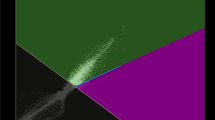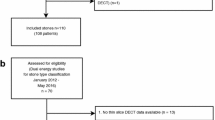Abstract
Purpose
To retrospectively evaluate the accuracy of dual-energy CT (DECT) in the detection of the chemical composition of urinary calculi in correlation with infrared spectroscopic stone analysis.
Methods
We reviewed the CT scans of 255 patients who underwent DECT due to a clinical suspicion of urolithiasis. Out of this group, we included 64 patients with clinically symptomatic urolithiasis requiring stone removal. After surgical removal of the stone by ureterorenoscopy, chemical composition was analyzed with infrared spectroscopy. We correlated DECT stone characterization results with chemical stone composition based on dual-energy indices (DEI). A total of 213 renal and ureteral stones could be removed and chemically analyzed.
Results
A total of 213 calculi were evaluated. Thirty eight out of sixty four (59 %) patients had >1 stone. DECT was used to differentiate stones by using DEI. Stones harboring calcium (CA) were color-coded in blue, while stones containing uric acid (UA) were colored red. Median DEI in UA-containing stones were 0.001. Non-UA-containing stones had a DEI between 0.073 for pure CA stones and 0.077 containing CA and other substances (p = 0.001; p = 0.03, respectively). Sensitivity of DECT was 98.4 % for differentiation of UA from non-UA-containing calculi. Specificity was 98.1 %. Mean effective radiation dose of DECT was 4.18 mSv (0.44–14.27 mSv), thus comparable to conventional CT scans of the abdomen. Conventional measurement of Hounsfield units did not correlate with stone composition.
Conclusion
DECT with image post-processing reliably discriminates UA-containing calculi from all other stones, but the study offered limitations. Discrimination within the non-UA stones cannot be reliably achieved but is clinically insignificant.




Similar content being viewed by others
References
Litwin M, Saigal C (2007) Urologic diseases in America. NIH Publication No. 07–5512. Washington, DC: US Department of Health and Human Services. Public Health Service, National Institutes of Health, National Institute of Diabetes and Digestive and Kidney Diseases, US Government Publishing Office
Curhan GC (2007) Epidemiology of stone disease. Urol Clin North Am 34(3):287–293
Smith RC, Rosenfield AT, Choe KA, Essenmacher KR, Verga M, Glickman MG et al (1995) Acute flank pain: comparison of non-contrast-enhanced CT and intravenous urography. Radiology 194(3):789–794
Türk C, Knoll T, Petrik A, Sarica K, Straub M, Seitz C (2011) Guidelines on urolithiasis. European Association of Urology, pp 12–15
Saita A, Bonaccorsi A, Motta M (2007) Stone composition: where do we stand? Urol Int 79(Suppl 1):16–19
Deveci S, Coskun M, Tekin MI, Peskircioglu L, Tarhan NC, Ozkardes H (2004) Spiral computed tomography: role in determination of chemical compositions of pure and mixed urinary stones—an in vitro study. Urology 64(2):237–240
Nakada SY, Hoff DG, Attai S, Heisey D, Blankenbaker D, Pozniak M (2000) Determination of stone composition by noncontrast spiral computed tomography in the clinical setting. Urology 55(6):816–819
Johnson TR, Krauss B, Sedlmair M, Grasruck M, Bruder H, Morhard D et al (2007) Material differentiation by dual energy CT: initial experience. Eur Radiol 17(6):1510–1517
Ferrandino MN, Pierre SA, Simmons WN, Paulson EK, Albala DM, Preminger GM (2010) Dual-energy computed tomography with advanced postimage acquisition data processing: improved determination of urinary stone composition. J Endourol/Endourol Soc 24(3):347–354
Li XH, Zhao R, Liu B, Yu YQ (2013) Determination of urinary stone composition using dual-energy spectral CT: initial in vitro analysis. Clin Radiol 68(7):370–377
Yildirim D, Ozturk O, Tutar O, Nurili F, Bozkurt H, Kayadibi H et al (2014) A new method for computer-assisted detection, definition and differentiation of the urinary calculi. Ren Fail 36(8):1278–1282
Manglaviti G, Tresoldi S, Guerrer CS, Di Leo G, Montanari E, Sardanelli F et al (2011) In vivo evaluation of the chemical composition of urinary stones using dual-energy CT. Am J Roentgenol 197(1):76–83
Stolzmann P, Leschka S, Scheffel H, Rentsch K, Baumüller S, Desbiolles L et al (2010) Characterization of urinary stones with dual-energy CT: improved differentiation using a tin filter. Invest Radiol 45(1):1–6
Ngo TC, Assimos DG (2007) Uric acid nephrolithiasis: recent progress and future directions. Rev Urol 9(1):17–27
Eaton SH, Cashy J, Pearl JA, Stein DM, Perry K, Nadler RB (2013) Admission rates and costs associated with emergency presentation of urolithiasis: analysis of the Nationwide Emergency Department Sample 2006–2009. J Endourol/Endourol Soc 27(12):1535–1538
Ansari MS, Gupta NP, Hemal AK, Dogra PN, Seth A, Aron M et al (2005) Spectrum of stone composition: structural analysis of 1050 upper urinary tract calculi from northern India. Int J Urol 12(1):12–16
Motley G, Dalrymple N, Keesling C, Fischer J, Harmon W (2001) Hounsfield unit density in the determination of urinary stone composition. Urology 58(2):170–173
Mostafavi MR, Ernst RD, Saltzman B (1998) Accurate determination of chemical composition of urinary calculi by spiral computerized tomography. J Urol 159(3):673–675
Qu M, Yu L, Cardona DG, Liu Y, Duan X, Ai S et al (2015) Radiation dose reduction in dual-energy CT: does it affect the accuracy of urinary stone characterization? Am J Roentgenol 205(2):W172–W176
Author’s contribution
A. Spek wrote the manuscript and was involved in project development and data management; F. Strittmatter was involved in data collection and data management; A. Graser was involved in data collection and edited the manuscript; P. Kufer was involved in data collection and analysis; C. Stief was involved in project development; M. Staehler edited the manuscript.
Author information
Authors and Affiliations
Corresponding author
Ethics declarations
Conflict of interest
The authors declare that they have no conflict of interest.
Ethical standards
All procedures performed in studies involving human participants were in accordance with the ethical standards of the institutional and national research committee and with the 1964 Declaration of Helsinki and its later amendments or comparable ethical standards.
Rights and permissions
About this article
Cite this article
Spek, A., Strittmatter, F., Graser, A. et al. Dual energy can accurately differentiate uric acid-containing urinary calculi from calcium stones. World J Urol 34, 1297–1302 (2016). https://doi.org/10.1007/s00345-015-1756-4
Received:
Accepted:
Published:
Issue Date:
DOI: https://doi.org/10.1007/s00345-015-1756-4




